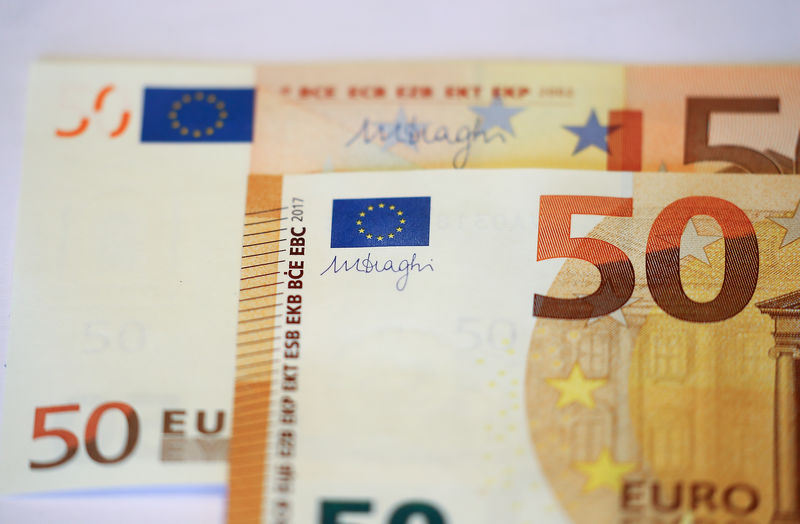LONDON (Reuters) – Record-low borrowing costs and falling debt payments could give the euro zone a 140 billion-euro windfall by the end of 2021, freeing cash for projects ranging from new roads to climate protection.
This year’s slide in borrowing costs has put the bloc’s finances in a far stronger position — cutting the interest rates it pays, allowing governments to cheaply refinance older debt, and above all leaving them with cash in hand.
That’s bolstering the case of those who argue the euro zone can and should spend its way out of economic doldrums. With Germany teetering near recession and the European Central Bank’s monetary policy looking maxed out, many now regard government spending as the key to lifting growth and inflation.
At current yields, euro zone governments will save an average 0.10% of gross domestic product in interest this year, or almost 12 billion euros, Frank Gill, senior director in the sovereigns team at ratings agency S&P Global, estimates.
Savings would rise to 0.25% of GDP in 2020 and 0.80% in 2021, Gill says, noting this was above already expected savings, and the long tenor of euro securities means debt savings increase over time.
The savings would total around 140 billion euros — to put that in context, pent-up demand in Germany for public investment amounts to 138 billion euros, state-owned development bank KfW estimates.
“It is very significant, this is a windfall really,” Gill said. “Since 2013-14, the decline in interest expenditure to GDP, especially in places like Italy and Spain, has given governments some breathing space.
“(Savings will be )much greater for those sovereigns which have seen larger yield compression, namely, Italy, Portugal, and Spain, and the savings snowball over the next two years.”
According to Societe Generale, a 10-basis-point drop in bond yields translates into roughly a fall in interest payments of 0.35% of GDP for Italy, 0.27% in Spain, 0.22% in France and 0.16% in Germany.
From environment projects in Germany to greater education and welfare spending in Italy and infrastructure improvements across the euro zone, the fall in borrowing costs could finally spell the end of austerity.
Ten-year bond yields, the usual reference rate for borrowing costs, have fallen by half to two-thirds this year. With the ECB resuming rate cuts and dropping time constraints on asset purchases, yields have little impetus to rise.
(Graphic: Annual fall in 10-year EZ borrowing costs , here)
Until now, euro zone monetary stimulus has effectively been counteracted by stringent budgets. ECB President Mario said last week that if fiscal measures had been in place, they would have complemented central bank policy and boosted growth.
Globally too, there is a perception that central banks are nearing the limits of what they can achieve. Former U.S. Treasury official Lawrence Summers calls it “black hole monetary economics”, where small rate changes and aggressive stimulus strategies have only limited impact.
Jorge Garayo, senior rates strategist at Societe Generale, noted that U.S. President Donald Trump’s fiscal spending plans had boosted inflation expectations in 2016.
“That had a much bigger impact than QE (quantitative easing),” he said. “With diminishing returns from monetary policy easing, the only thing that could push (Europe’s) inflation expectations sustainably higher is if we go through a credible fiscal stimulus, most likely coordinated in some way.”
(Graphic: The euro zone’s debt load, here)
OPPORTUNITY KNOCKS
Euro zone governments have been saving on interest for years as ECB QE drove down yields. The savings amounted to almost 2% of GDP since 2008, Unicredit estimates.
The question is, will the budget room now being created persuade fiscal hawk Germany to drop its opposition to more saved over 160 billion euros in interest since 2008. This year’s windfall, following a 70-basis-point slide in 10-year yields, may exceed 5 billion euros, Reuters has reported.
Stewart Robertson, senior economist at Aviva Investors reckons if Germany’s 10-year bond yields stay around -0.50% and it can raise debt at this level for four to five years, it would save some 15 billion to 20 billion euros annually.
There are caveats. Lower yields can take years to feed through. Benefits accrue only when yields fall and stay low for some time. Persistently low yields would also signal economic weakness, in turn threatening tax receipts.
ITALIAN JOB
Italy, one of the bloc’s most indebted members, probably has most cause to celebrate low yields. Desperate to revive its sluggish economy, it has frequently clashed with EU authorities for overstepping spending limits.
Now, though, the tumble in its 10-year borrowing costs, to 0.9% from 2.6% in early 2019, is defusing concern over its 2020 budget, due to be submitted next month.
Assuming unchanged yields, Rome can save up to 20 billion euros a year in interest payments, or 1% of annual economic output, Pictet Wealth Management strategist Frederik Ducrozet calculates. That assumes interest payments are spread over the years and yields stay low.
The government hopes to use that budget leeway to avoid an upcoming sales tax increase. Ducrozet noted the Bank of Italy is also profiting from its 400 billion euros of bond holding, most of it bought under ECB QE. That will partly be redistributed to state funds.
“In plain English, the Treasury is saving money on all fronts, probably over 1% of GDP on an annual basis,” Ducrozet said. “If the political situation were to improve for whatever reason – arguably a big IF – the fiscal picture would improve dramatically.”





